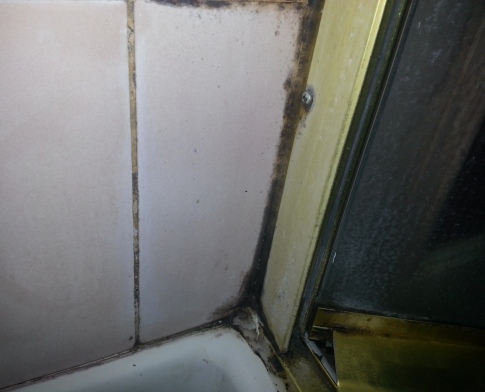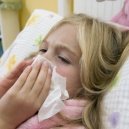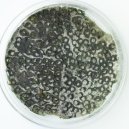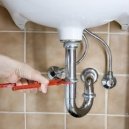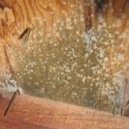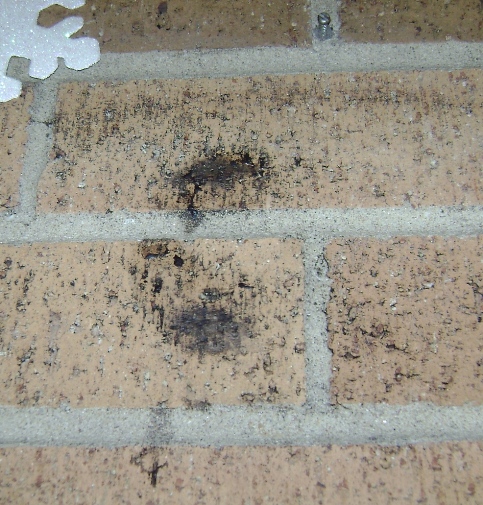Find a pre-screened local mold removal specialist Free Estimate
Find a Mold Specialist Now
Click or Call, Toll-Free 24/7
Mold Stain Removal
Mold stain removal can be challenging, even after you have removed the mold itself. Unfinished areas of the home such as the basement and attic are often susceptible to mold stains, as these areas are not typically seen and the longer the mold lives, the longer the stains can penetrate the surface of the material. Wood decks and concrete are also susceptible to mold stains because they have porous surfaces that allow the mold stains to penetrate deep, making them harder to clean. Not all mold stains can be removed, but there are some steps you can take to reduce or eliminate staining.
What Causes Mold Stains?
To understand mold stains, it helps to understand the structure of mold. Mold is a fungus that grows in multi-cellular filaments called hyphae. These hyphae produce pigment, or color. Mold colors can range from white or gray to green, red, brown or black, and the darker the color, the more pigment it produces.
As these mold hyphae grow into the material of your home, be it wood, drywall, fabric or others, the pigment can transfer to that material. So, even if you kill or remove the mold, the pigment is left behind.
Are Mold Stains Dangerous?
Unlike the mold itself, any stains left behind after you have removed the mold are harmless. However, mold stains are an aesthetic problem and removing the mold stains is important for property value and improving the appearance of your home.
While you may choose to ignore mold stains in an unobtrusive area of your home like the basement or attic, you should never ignore the growth of mold. Mold can grow on most surfaces in your home including tile grout, wood, carpet, drywall/sheetrock, ceiling tile, painted surfaces, fabric and paper. Unchecked mold growth can cause damage by eroding the structural integrity of beams, trusses, walls, ceilings, floors and more.
In addition, mold growth is a sign that you have a water problem that needs to be addressed immediately. You must identify the source of the water, whether it is a leaky pipe, humid bathroom, broken appliance, septic tank backup or storm water infiltration, and perform the necessary repairs.
Mold growth is also dangerous because it is a known health hazard. Mold acts as an allergen, and if you breathe in mold spores you may experience sneezing, nasal and sinus congestion, asthma symptoms, itchy eyes and more. Over time, your symptoms may get worse or you may experience fungal infections or chronic rhinitis or asthma. Mold can cause more serious, long-term health problems in young children, the elderly and people with other health conditions or compromised immune systems.
Mold Stain Removal Guidelines
Mold stain removal depends upon the material where the staining has occurred. You can try using soap, vinegar and household cleaners to remove stains. For difficult to remove mold stains, we recommend Concrobian Mold Stain Eraser. It is bleach-free, so it won’t damage surfaces. It is safe to use on wood, stone, fiberglass, plastic, laminate, metal, aluminum and concrete.
Grout: Mold growth in grouts cannot be satisfactorily removed because it grows into the grout. If you try to clean it, it will quickly grow back. The grout has to be dugout and replaced with new grout.
Wood: Mold stain removal on wood such as flooring, decks, fences or wood trim may require a trip to the hardware store. But first, try cleaning with ingredients you probably have in your kitchen. To clean surface wood stains, mix vinegar, mild dish soap, and water. Dip a rag in the vinegar mixture and wipe the wood. Wipe again with another damp rag, and dry thoroughly. If the mold grows back in a week or two, that means it has penetrated the surface.
If the mold has penetrated the surface of the wood, you will need to sand it to remove it all. Sanding can be dangerous because it will release mold spores. Always wear an N-95 face mask when sanding moldy wood, and only sand wood that is located outdoors. Using #100-grit sandpaper, sand the wood in a circular motion wherever you see mold. Then follow up with #220-grit sandpaper. Use a HEPA-vacuum to clean up the dust after sanding. Now you can repaint or re-stain the wood. If you are unable to completely remove the mold because it has penetrated too deeply, you should replace the wood.
If the wood is located indoors, it is not safe to sand it yourself. The risk of inhaling or spreading mold spores is too great. For small amounts of mold on wood inside, clean as much as possible by scrubbing with a cleaner, allow the surface to dry, and then encapsulate any remaining mold with a commercial mold sealant, like Foster 40-50. If the mold covers more than 10 square feet, the U.S. Environmental Protection Agency (EPA) recommends hiring a professional removal company.
Walls and Ceilings: Walls and ceilings are usually porous, so if the mold has penetrated the material, it will need to be replaced. To clean surface mold from painted walls and ceilings, use a mold cleaner. Spray the affected area and scrub with a soft brush or rag to remove the mold. If staining still shows then the mold has penetrated the surface, and the material should be replaced.
Make sure that all of the mold has been removed before repainting. Otherwise, the mold will continue to grow and return.
Masonry Surfaces: Unpainted masonry surfaces, such as walls and ceilings, constructed of unpainted concrete cinder blocks, poured concrete, cement boards, clay blocks, ceramic tiles, plaster, marble, and granite, do not support mold growth. However, white salt deposits that migrate to the surface can have elevated levels of mold and bacteria. Also, if the masonry surface was painted, mold can grow on the paint. Remove the mold by spraying the surface with water, then use a wire brush or scraper to remove the salt deposits and loose paint. Allow it to dry, HEPA-vacuum, and then spray with a fungistatic disinfectant such as RMR-141. Any remaining stain can be removed using Concrobian Mold Stain Eraser.
Leather: Mold on the surface of leather can be cleaned using either mild soap or vinegar. If you choose to use soap, mix a solution of gentle detergent or saddle soap and water in a spray bottle. Spray the stained leather and wipe with a clean, dry cloth. Or you can spray vinegar and wipe it off, or wipe the leather with a cloth soaked in vinegar. In either case, don’t let the surface get or stay too wet, otherwise the moisture can permanently damage the leather. If mold has penetrated the surface, it will come back, and the leather will need to be discarded.
Clothing: Your success in removing mold stains from clothing can depend on the fabric and how long the stain has been sitting. For white cotton fabrics, wash with chlorine bleach according to the instructions that came with your washing machine or on the bleach bottle. For colored fabrics, use a wash booster like OxiClean or pretreat the stain with a stain lifter. It may be helpful to let the item soak in OxiClean before washing. For delicate fabrics, items that are not machine washable, or stains that don’t come out with the other suggested methods, you can try taking it to a dry cleaner. Be sure to point out the stain so they can treat it properly. If the mold cannot be removed, the clothing should be disposed of.
How to Get Help
If you suspect you have mold growing in your home, or you have mold stains that you just can’t get rid of, call 877-215-2832 to get immediate, 24-hour assistance. You will be connected to a local professional who can handle mold identification, remediation and repair work, even dealing with mold stain removal. They will come to your home and give a free inspection and estimate.
Return From Mold Stain Removal To Our Main Remediation Page
Free Home Inspection By A Mold Removal Specialist
Search This Website
Recent Articles
-
See Our 5 Recommended Mold Removal Companies in Covington, KY
Apr 16, 25 12:59 PM
-
See Our 5 Recommended Mold Removal Companies in Wheaton, IL
Jun 20, 24 10:33 AM
-
See Our 5 Recommended Mold Removal Companies in Aberdeen, SD
Oct 08, 21 04:05 PM
